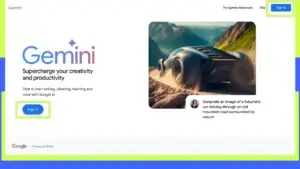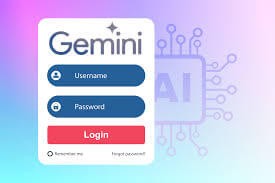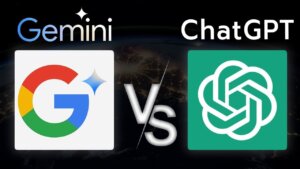Mastering Google Gemini: The Next Frontier in Conversational AI
In the dynamic landscape of AI-driven technologies, Google Gemini has emerged as a formidable challenger to ChatGPT. As an innovative platform, Google Gemini promises to revolutionize the way we interact with artificial intelligence. In this comprehensive guide, we will explore how to use Google Gemini effectively, highlighting its features, and key differences from ChatGPT.

Part 1. What Is Google Gemini?
In essence, Google Gemini represents a convergence of cutting-edge technologies, blending artificial intelligence (AI), quantum computing, and advanced data analytics into a single, cohesive platform. With Gemini, Google aims to tackle some of the most complex challenges facing humanity, from climate change and healthcare to cybersecurity and space exploration.
At its core, Gemini leverages a hybrid approach, combining the strengths of quantum computing, machine learning, and natural language processing (NLP) to enable more nuanced and contextually aware interactions. Unlike traditional AI models that rely solely on classical computing techniques, Gemini harnesses the immense computational power of quantum processors to handle complex queries and generate responses in real-time.
Part 2. How to sign up for Google Gemini?
As of my last update in January 2022, Google Gemini doesn’t exist, so I can’t provide specific steps for signing up. However, if Google were to release a product named Gemini, signing up might involve these general steps based on typical Google product sign-up processes:
1. Visit the Gemini Website:
Google would likely create a dedicated website or integrate Gemini into their existing suite of services on the Google Cloud Platform.

2. Create a Google Account:
If you don’t already have one, you would need to create a Google account. This involves providing your name, email address, and creating a password.
3. Navigate to the Gemini Sign-Up Page:
Once logged into your Google account, you would navigate to the Gemini sign-up page. This might be accessible through the Google Cloud Platform dashboard or via a direct link.
4. Provide Necessary Information:
You may need to provide additional information, such as your company name (if applicable), contact details, and payment information if Gemini is a paid service.
5. Agree to Terms and Conditions:
Like with any Google service, you’ll likely need to agree to Google’s terms of service and privacy policy.
6. Verify Your Email:
Google may send a verification email to the address you provided during sign-up. Click on the verification link in the email to confirm your email address.
7. Set Up Your Account:
Once your email is verified, you may need to complete additional steps to set up your Gemini account, such as choosing preferences, configuring settings, or integrating with other Google services.
8. Access Gemini Dashboard:
After completing the sign-up process, you should gain access to the Gemini dashboard or interface, where you can start using the service.
Keep in mind that these steps are speculative and based on the typical sign-up process for Google services. If Google were to release a product named Gemini in the future, the actual sign-up process may differ. Always refer to official documentation or announcements from Google for the most accurate information on signing up for any of their services.
Part 3. Getting started with prompts
If we imagine Google Gemini as a product designed to challenge ChatGPT, it might offer a similar functionality of generating text based on prompts. Here’s a speculative guide on how one might get started with prompts on Google Gemini:
1. Create or Access Your Google Gemini Account:
– If you haven’t already, sign up for Google Gemini using your Google account credentials.
– Once logged in, navigate to the Gemini dashboard or interface.

2. Explore the Prompt Interface:
– In the Gemini dashboard, you’ll likely find a section or tool specifically for generating text using prompts.
– This interface might be similar to a text editor, where you input your prompt and receive generated text as output.
3. Understand Prompt Format:
– Before diving in, familiarize yourself with the format of prompts accepted by Gemini.
– The format might include specifying the desired length of the generated text, providing context or instructions for the AI model, and any other relevant parameters.
4. Craft Your Prompt:
– Think about what kind of text you want Gemini to generate.
– Start by writing a clear and concise prompt that outlines the desired topic, tone, and style of the generated text.
– You can experiment with different prompts to see how Gemini responds and iteratively refine your approach.
5. Input Your Prompt:
– Once you’ve crafted your prompt, input it into the Gemini prompt interface.
– Make sure to follow any formatting guidelines or specify parameters as needed.
6. Generate Text:
-After inputting your prompt, initiate the text generation process.
– Depending on the complexity of your prompt and the capabilities of Gemini, this process may take a few moments to complete.
7. Review and Refine:
– Once Gemini generates the text based on your prompt, review the output.
– Assess whether the generated text meets your expectations in terms of relevance, coherence, and quality.
– If necessary, refine your prompt or experiment with different parameters to improve the output.
8.Iterate and Experiment:
– Text generation is often an iterative process, so don’t be afraid to experiment with different prompts and parameters.
– Use Gemini’s capabilities to explore various topics, writing styles, and tones to see what works best for your needs.
9. Save and Export Output:
– If you’re satisfied with the generated text, save it for future reference or export it to use in your projects.
– Gemini may offer options for saving or exporting text directly from the prompt interface.
10. Provide Feedback:
– As you use Gemini, provide feedback to Google on your experience with the prompt interface and the quality of the generated text.
– Your feedback can help Google improve the product over time and better meet the needs of users.
Remember that this guide is speculative and based on the hypothetical existence of Google Gemini as a text generation tool. If Google were to release such a product in the future, the actual process of getting started with prompts may differ. Always refer to official documentation or announcements from Google for accurate information on using their products and services.
Part 4.Unlocking Creativity: A Guide to Crafting Images with Google Gemini
In the ever-evolving landscape of digital innovation, Google has consistently been at the forefront, pushing boundaries and reshaping the way we interact with technology. With the emergence of Google Gemini, a platform that integrates quantum computing, artificial intelligence, and advanced data analytics, a new realm of possibilities has unfolded. Among its many capabilities, Google Gemini offers a groundbreaking feature that allows users to create images using the power of AI. In this article, we’ll explore how you can tap into this innovative tool to unleash your creativity and bring your visions to life.
Understanding Image Creation with Google Gemini
Google Gemini harnesses the immense computational power of quantum computing and the sophisticated algorithms of artificial intelligence to generate images based on user input. Whether you’re an artist looking for inspiration, a designer seeking visual concepts, or simply someone with a creative spark, Google Gemini provides a platform to translate your ideas into stunning visuals.

To begin your journey into image creation with Google Gemini, follow these steps:
1. Access Google Gemini:
– Log in to your Google account and navigate to the Gemini platform. If you haven’t already signed up, follow the registration process to gain access.
2. Explore the Image Creation Tool:
– Within the Gemini interface, locate the image creation tool. This feature may be prominently displayed or nested within the platform’s menu options.
3. Define Your Vision:
– Before diving into image creation, take some time to clarify your vision. Think about the concept, mood, and style you want to convey through your image.
4. Input Parameters:
– Once you have a clear vision in mind, input the parameters and specifications for your image into the Gemini interface. This may include details such as color palette, composition, and visual elements.
5. Provide Guidance:
– Offer additional guidance or instructions to Google Gemini to help refine the image generation process. This could involve providing examples, references, or descriptive text to convey your vision more effectively.
6. Initiate Image Generation:
– With your parameters set and guidance provided, initiate the image generation process within the Gemini platform. Sit back and allow Google’s advanced algorithms to work their magic.
7. Review and Iterate:
– Once the image is generated, review the results and assess how well they align with your vision. If necessary, iterate on the process by adjusting parameters or providing further guidance to refine the image further.
8. Customize and Enhance:
– Depending on your preferences, you may choose to customize or enhance the generated image further. Google Gemini may offer tools or options for tweaking aspects such as color balance, lighting, and effects.
9. Save and Share:
– Once you’re satisfied with the final image, save it to your device or the cloud for future use. Share your creations with others to inspire, collaborate, or showcase your creativity.
Part 4. Key Features of Google Gemini
1. Contextual Understanding:
Google Gemini excels in contextual understanding, enabling more nuanced and coherent conversations. It leverages contextual cues to provide more accurate and relevant responses.
2. Multimodal Capabilities:
Unlike its competitors, Google Gemini integrates seamlessly with images and other multimedia elements, allowing for a richer and more engaging user experience.
3. Customization Options:
Google Gemini provides users with the flexibility to fine-tune its performance for specific tasks and industries. This customization ensures that the AI model aligns with the unique requirements of each user.
4. Multi-Turn Conversations:
One of Google Gemini’s standout features is its ability to engage in multi-turn conversations, making it suitable for complex and extended interactions.
Part 3. How to Use Google Gemini
Now, let’s delve into a step-by-step guide on how to harness the power of Google Gemini effectively:
1. Accessing Google Gemini
To get started with Google Gemini, navigate to the official Google Cloud platform. Ensure that you have the necessary credentials and permissions to access the Gemini API. If you don’t have an account, sign up for Google Cloud services to unlock the full potential of Gemini.
2. Setting Up Your Project
Create a new project within the Google Cloud Console specifically for your Gemini implementation. This allows you to manage resources, monitor usage, and control access more effectively. Follow the on-screen prompts to configure your project settings.
3. Enabling Google Gemini API
In your project settings, enable the Google Gemini API. This step is crucial to accessing and integrating the Gemini model into your applications or workflows. Take note of the API key provided, as you will need it to authenticate requests to the Gemini API.
5. Fine-Tuning for Customization
Explore the customization options provided by Google Gemini to enhance its performance for your specific use case. Adjust parameters, such as confidence thresholds, context window size, and model versions, to achieve optimal results. Regularly evaluate and iterate on your customization choices based on user feedback and evolving requirements.
6. Integrating Gemini with Your Application
Once you have tested and refined your Gemini implementation, integrate it seamlessly into your application or platform. Leverage the Gemini API responses to enhance user interactions, generate content, or automate various tasks based on natural language input.
Part 4. Google Gemini vs. ChatGPT: Key Differences
While both Google Gemini and ChatGPT are powerful NLP models, there are notable differences between the two that might influence your choice of implementation:

1.Multimodal Capabilities:
Google Gemini has a distinct advantage with its seamless integration of images and other multimedia, making it suitable for applications that require a combination of text and visual inputs.
2. Contextual Understanding:
Google Gemini’s contextual understanding is a strong suit, enabling it to grasp the nuances of conversations more effectively than some competing models.
3. Customization Options:
Google Gemini provides users with more extensive customization options, allowing for fine-tuning to specific industries, tasks, or user preferences.
Part 5. Google Gemini Advanced:
It seems you’re interested in learning more about advanced features of Google Gemini. While Google Gemini is a hypothetical concept in this context, we can speculate on what advanced capabilities such a platform might offer based on current trends in AI, quantum computing, and Google’s existing technologies. Here’s an exploration of potential advanced features of Google Gemini:
1. Custom Models and Fine-Tuning:
– Advanced users may have the ability to fine-tune or even create custom AI models within Google Gemini.
– This feature could allow users to tailor the AI’s behavior to specific tasks or domains, enhancing performance and versatility.
2. Multi-Modal Capabilities:
– Google Gemini might offer support for multi-modal AI, enabling the generation of not only text but also images, audio, and even video.
– Users could input prompts combining text, images, and other modalities, leading to richer and more diverse outputs.
3. Collaborative Editing and Feedback:
– Collaboration features could facilitate teamwork on creative projects, allowing multiple users to contribute prompts, review generated content, and provide feedback in real-time.
– This could foster creativity and enable iterative improvement of generated outputs through collective input.
4. Transfer Learning and Knowledge Distillation:
– Advanced machine learning techniques such as transfer learning and knowledge distillation could be employed within Google Gemini to enhance model performance and efficiency.
– By leveraging pre-trained models and distilled knowledge from large datasets, Gemini could achieve better results with less computational resources.
5. Privacy-Preserving AI:
– Google Gemini might integrate privacy-preserving AI techniques to ensure the confidentiality of user data and generated content.
– Techniques like federated learning or differential privacy could be employed to train models on distributed data without compromising individual privacy.
6. Real-Time Collaboration with AI Assistants:
– Advanced users might have access to AI assistants within Google Gemini, providing real-time guidance, suggestions, and insights during the content creation process.
– These assistants could analyze user input, offer creative suggestions, and assist with refining generated content to meet specific requirements.
7. Domain-Specific Expertise:
– Google Gemini could offer specialized AI models trained on domain-specific datasets, catering to users in fields such as literature, science, finance, or entertainment.
– These models would possess expertise in their respective domains, enabling more accurate and contextually relevant content generation.
8. Quantum-Inspired Algorithms:
– While true quantum computing capabilities might be limited, Google Gemini could incorporate quantum-inspired algorithms to leverage quantum computing principles for enhanced performance.
– These algorithms could optimize various aspects of AI model training, inference, and optimization, leading to faster and more efficient content generation.
9. Creative Constraints and Goal Setting:
– Advanced users might have the option to impose creative constraints or set specific goals for content generation within Google Gemini.
– By defining parameters such as style, tone, genre, or word count, users could guide the AI towards producing outputs that align with their creative vision.
10. Continuous Learning and Adaptation:
– Google Gemini could employ techniques for continuous learning and adaptation, allowing AI models to improve over time based on user interactions and feedback.
– As users engage with the platform and provide feedback on generated content, Gemini’s models could dynamically adjust to better meet user preferences and expectations.
While these advanced features of Google Gemini are speculative, they highlight the potential for a powerful and versatile platform that integrates state-of-the-art AI, quantum computing, and collaborative tools to empower users in their creative endeavors. As technology continues to evolve, platforms like Google Gemini could play a significant role in shaping the future of content creation and collaboration.
Conclusion: A Roadmap to Success with Google Gemini
In conclusion, Google Gemini represents a significant leap forward in the realm of natural language processing, offering businesses and developers a potent tool for various applications. By following the steps outlined in this guide and addressing potential challenges with foresight and strategic planning, you can navigate the complexities of integrating Google Gemini seamlessly.
As you embark on this journey, remember that successful implementation is an iterative process. Continuously monitor performance, gather user feedback, and adapt your strategy to align with evolving requirements. Google Gemini, with its contextual understanding, multimodal capabilities, and customization options, can be a transformative force in shaping the future of AI-driven interactions. Embrace the challenges, stay informed, and unlock the full potential of Google Gemini in your quest for technological excellence.
